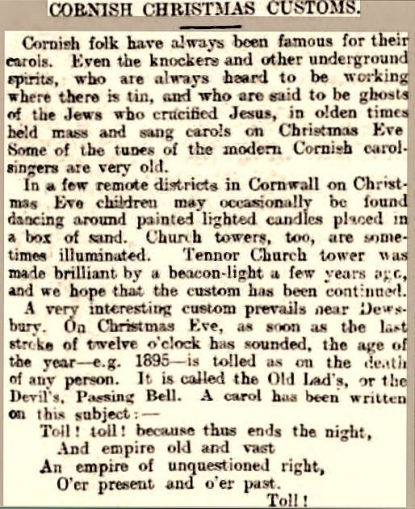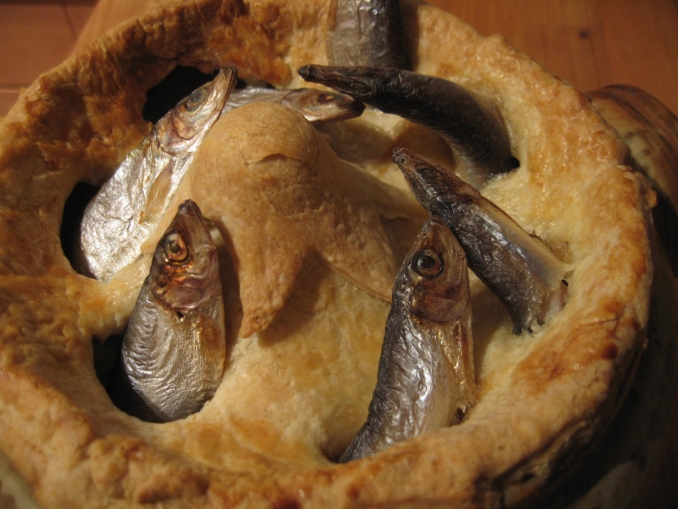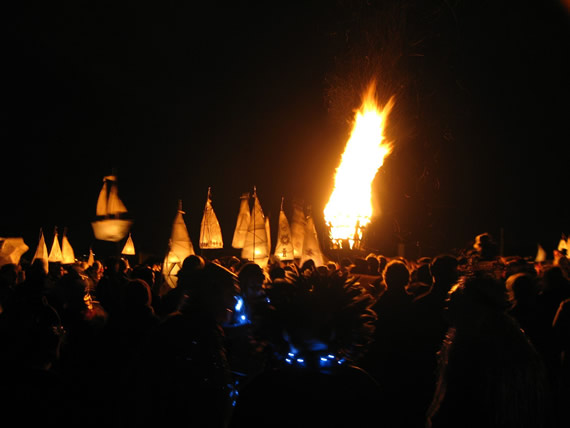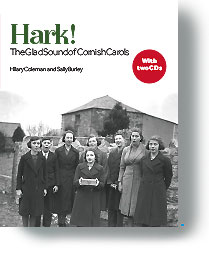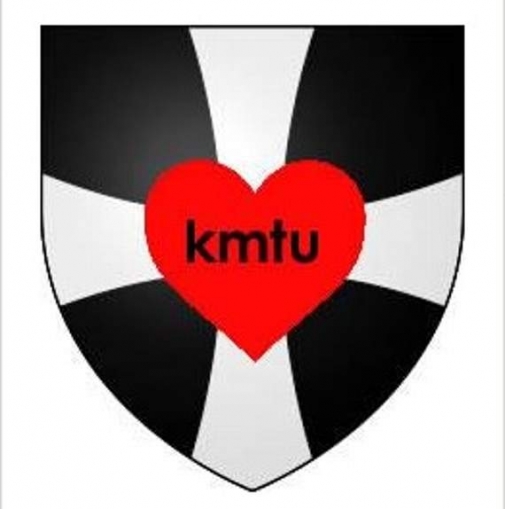Thank Cornwall for Christmas!
The Cornish kept Christmas when the rest of Britain had given up on it.
Christmas (Nadelik) was celebrated in Cornwall when it had become unfashionable to do so across the rest of Britain.
In fact many of the customs we now think of as Christmas traditions were collected in places like Cornwall in the early 19th Century.
Numerous distinctive traditions and practices are associated with this time of year in Cornwall including:
• The Cornish Christmas Bunch
• Cornish church towers being illuminated on Christmas Eve
• Triumphal arches of evergreens and flags were often seen in towns and villages
• Guise-dancing – Participants dressed in gentlemen’s hand me downs and wearing masks would tour the town entertaining others with music and dance. Often led by a “Lord of Misrule” or master of ceremonies.
• Candle Dancing – dancing around a basket full of sand with brightly coloured candles in it
• The Twelfth cake – And the general celebration of 12th night as a feast.
• The lighting and chalking of the Mock or Block. It was a tradition to draw a chalk man on the Christmas or yule log to symbolise the death of the old year and the start of the new. This was a communal activity and is still performed in public during the Montol festival in Penzance.
• The Cornish Christmas Carol – Cornwall has provided a surprisingly large number of Carols known throughout the world.
• The distinctive tunes of the regional Cornish Carols such as the St Ives and Padstow carols.
• The distinctive Cornish carol tunes composed by Thomas Merritt.
• The Cornish play of “Saint George and the Turkish Knight and its variants. A variant on the story popularly played out by mummers across the UK with local variants.
(with thanks to our friends of the Cornish Cultural Association)
(see 1901 newspaper cutting attached)
Tom Bawcock's Eve
December 23rd in Mousehole
Tom Bawcock's Eve is a festival, observed on December 23 in the village of Mousehole.
Tom Bawcock was a local fisherman in the 16th century, and Tom Bawcock's Eve is held to remember that man and his act of heroism: according to the legend, one stormy winter, when no fishing boats were able to leave and all residents were facing starvation, Tom Bawcock on December 23, however, went out for fishing.
He gave the entire catch to the residents and they baked a Stargazy pie together.
Ever since, the Tom Bawcock's Eve festival takes place as a memorial day to Tom Bawcock's efforts.
During the festival, Stargazy pie is eaten, and in the evening, all harbour lights are turned off so people can watch the illuminations and lantern parade. There is also carol singing on the beach.
"Merry place you may believe, Tiz Mouzel 'pon Tom Bawcock's eve
To be there then who wouldn't wesh, to sup o' sibm soorts o' fish
When morgy brath had cleared the path, Comed lances for a fry
Nex cumd fermaads, braa thustee jaads
As maad ar oozles dry,
An ling an haak, enough to maak
a raunen shark to sy!
And then us had a bit o' scad an' Starry-gazie pie
As aich we'd clunk, E's health we drunk, in bumpers bremmen high,
And when up caame Tom Bawcock's name, We'd prais'd 'un to the sky"
(see Starry Gazie Pie picture attached)
Montol Festival
16th Dec 2017 to 21st Dec 2017 in Penzance
The Montol Festival is a six day arts and community festival celebrating the midwinter solstice and Cornish traditions of the past, culminating in the main event, Montol Eve on December 21st.
Through the week there are lantern and mask making workshops, strolling bands, carol services, storytelling, Mummers Plays, a ceilidh and late night shopping in Penzance.
During the main event the people of Penzance take part in many of the Cornish traditional customs of Midwinter and Christmas including Guise dancing when many people wear traditional masks, dress in disguise and wear mock formal costume. Several fire beacons are lit throughout the town with the chalking and burning of the Mock, the Cornish Yule log and dancing to follow.
Montol Eve has the theme of light and darkness so during the proceedings you can listen to traditional music and singing, watch the amazing performers and join in the carols. There are fire-lit processions to watch, too.
Traditionally made from ash wood, the lighting of the Yule Log is an old Cornish tradition. A stickman, or woman, is chalked on the log as a symbol of the death of the old year and the birth of the new and then thrown on the fire.
( www.montol.info )
(see Montol picture attached)
Cornish Christmas Carols - Or 'Curls'
Before 1825 Christmas carols were dying out in Britain, and it is Davies Gilbert of St Erth who is credited with pioneering a revival, notably by the publication in 1822 of a collection titled ‘Some ancient Christmas carols and complete with their tunes’. This was followed in 1833 by ‘Christmas carols, ancient and modern’ by William Sandys, Commissioner of affidavits in the Stannary Court of Cornwall.
In Cornwall Methodism also helped to stimulate song. In those areas where Methodism was strongest, music and singing were strongest, and notably so at Christmas. The singers would practice in chapels and school-rooms, some of them walking miles to be there. They rehearsed folk songs and newer carols, such as Nahum Tate's ‘While Shepherds’ and Charles Wesley's ‘Hark the Herald Angels’.
Local musicians composed tunes themselves which was the start of a new tradition, with composers such as Thomas Merritt, Thomas Broad, R H Heath, W B Ninnis and many others providing a wealth of music with the soaring harmonies (and 'repeats') so beloved of the mining communities. The favourite carols were those which gave the best opportunities to exercise skills in 'parts' singing with trebles, altos, tenors and basses performing with gusto. The conventional restraint of polite choral music was not always the most obvious feature!
There are several well-appreciated annual 'carolares' in local chapels, for instance at Troon, Camborne and Redruth and in St Ives the carol service tradition has remained strong. The St Ives Cornish carol choir continue to meet and have a large following, particularly at their Christmas Eve singing of a number of well-known Cornish carols.
Local choirs sing the Thomas Merritt favourites and in Cornish communities overseas the singing of Cornish carols form an important part of Christmas celebrations.
At home, composers like the late Kenneth Pelmear revitalised interest in the 1970s and 80s with some success.
Amongst others, a Carol concert in Camborne Wesley Chapel on Sunday 3rd December at 7:45 pm will feature mainly Cornish carols by Merritt and being performed by Camborne Ladies Choir with Four Lanes Male Choir.
For a bit more information on Cornish carols, including Merritt, and the St Ives and Padstow traditions, and a bit about wassails and winter festivals in Cornwall have a look at this book, new out this year - Hark!
https://secure.francisboutle.co.uk/product_info.php?products_id=141
(see picture of Hark! attached)
For those greeting cards:
Seasons greetings (to you) - Gorhemmynadow an Seson (re 'gas bo)
Merry Christmas and a happy New Year (to you) - Nadelek Lowen ha Bledhen Noweth da (re 'gas bo)
With Christmas greetings - Gans gorhemmynadow Nadelek
(with) Every good wish for the Season - (gans) pup bolunjeth da rag an Seson
Merry Christmas from ... - Nadelek Lowen dhyworth
With love... - Gans kerensa
Christmas Church Services in Cornish:
• St Budock Parish Church, 3rd December from 15:00–16:00
• St Ive Methodist Church, 17th December from 14:30–15:30
• Bridge Methodist Church, 31st December from 15:00–16:00
Nadelek Lowen ha Bledhen Noweth da re 'gas bo!
Kernow by vyken!
John, Teresa, Craig, Tony, Matt, Clive, Ronan, Mark, Rob, Mike & Alex
Kernow Matters To Us Steering Group
